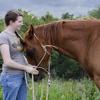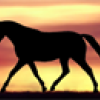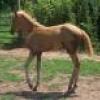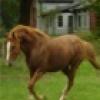Chestnut Quesion
Forums
Re: Chestnut Quesion
I never really noticed his dark tail until today, but looking through some pictures of our mares I noticed alot of them had it too so it's very possible I'm just crazy. Anyway, heres that mare I was talking about. Someone before said that frame likes to take the white away from the back half of the body ,I think, so it's possible.
http://www.equine-color.info/index.php?…" onclick="window.open(this.href);return false;
Re: Chestnut Quesion
Sooty is interesting since his body is very light chestnut.
I found a sweaty picture of him
http://www.equine-color.info/index.php?…" onclick="window.open(this.href);return false;
Re: Chestnut Quesion
[quote="admin"]Does he have a dorsal?[/quote]
He has countershading, but only on the very backend of his back.
Also his father was that paint stallion Doctor Color, and his mother was a chestnut QH that had like 1/4 thoroughbred in her.Not that that would make any difference.
And Wow that horse is very interesting.
Re: Chestnut Quesion
By a bay and out of a chestnut. Not sure what the pedigree says but the stallion looks too dark to be bay dun.
I agree his tone looked red dun, but his legs were too light to me to be dun. Lace is every bit as light as him and has a dorsal all the way up her back... and tested negative for dun. I think they have something similar going on. She's flaxen, but she has a stripe through her tail much darker than her body color.
Chex Nu Jewel is the stallion I posted.
Re: Chestnut Quesion
Oh, thanks. I once thought he could have been dun but his legs didn't seem dark enough for me either. When he was born he was really light and, as I remember, an odd color, but I cannot find any pictures at all.
I did find a non-sweaty picture of him next to his mom.
http://www.equine-color.info/index.php?…" onclick="window.open(this.href);return false;
Re: Chestnut Quesion
I'll have to look for a picture of Lace again.
I edited in some info for Smokeys parents...in Doc's pedigree it lists Yellow Mount as a red dun.
http://www.allbreedpedigree.com/index.p…" onclick="window.open(this.href);return false;
Off topic but, ACC I see you live in lexington! you should come visit!
Re: Chestnut Quesion
Here's a shot that shows her color well (bad pic though of course):
[img]http://i173.photobucket.com/albums/w65/…]
Dorsal:
[img]http://i173.photobucket.com/albums/w65/…]
Shoulder bars:
[img]http://i173.photobucket.com/albums/w65/…]
Dark stripe in her flaxen tail:
[img]http://i173.photobucket.com/albums/w65/…]
Re: Chestnut Quesion
I've kinda wondered that myself. She's too typical of stockhorse to me though and she is supposedly papered AQHA. I still think it's VERY, VERY possible there are different mutation of dun even within AQHA. I think that's why they're having such a hard time narrowing it down to one mutation.
Re: Chestnut Quesion
Question--with the UCDavis zygosity dun test, they want hair samples from parents as well as offspring...I take it that the one you used didn't, since you don't have access to her parents to take samples (right?)? So might this test not be as accurate as the zygosity test UCDavis does?
Diane
Re: Chestnut Quesion
My test was done at UC Davis, but I was unable to submit parent samples. They will do it without them, but they do qualify that it can effect the accuracy of the test.
I also don't believe it is 100% accurate, especially when you don't have parent samples. She WILL be retested if they ever find the actual mutation(S).
Re: Chestnut Quesion
Well, since Lacy tested negative for dun, it means that she almost certainly does not carry the dun mutation that exists in Quarter Horses, Morgans, Norwegian Fjords, Icelandics, Welsh, Minis, and a few other breeds. There is always the possibility that she carries some other mutation that is mimicking dun, but since she appears to be of QH lineage, it wouldn't be the traditional "dun" that we all see so often.
The test looks at a series of genetic markers around dun. Davis has the dun gene narrowed down to a very small region, and there is a very good candidate gene in that area. These genetic markers are all within this very small region. The test is based on something called "haplotyping." This means that when a mutation is passed down through many generations of horses, the alleles of genetic markers very close to that mutation are passed along with it. These markers "stay" with the mutation for hundreds of years or more. So when we look at a trait that is the same in many different breeds of horses, what we usually see is the same series of genetic markers in all horses of all breeds that carry that trait. Haplotyping has been used to map many traits of interest in many species.
So for dun, as an example, let's say that there are a series of markers (A, B, C, D, and E) around dun. When we look at Quarter Horses , we see that dun QH's all have alleles A/b/c/D/e. Horses homozygous for dun type as AA/bb/cc/DD/ee. ALL dun QH's have those alleles. Then we say, okay, let's go look at other breeds that have dun. So we go look at, say, Morgan Horses. And lo! We see that all dun Morgan Horses also have A/b/c/D/e. That tells us that QH's and Morgans both got dun from the same long-ago ancestor, and those alleles have been passed down from that ancestor into both breeds.
Now, after looking at many breeds with dun, we see the same A/b/c/D/e haplotype in all of them, [i]except[/i] some of these Spanish breeds, like Lusitanos, Andalusians, etc. These horses have dorsals and leg barring and look dilute, but they don't have the haplotype. And if you look closely at these horses, it doesn't quite look exactly the same as traditional dun. The coats aren't quite as dilute, and the dorsals not quite as prominent. This tells researchers that whatever causes this dun-like phenotype in these Spanish breeds is probably different than the traditional "dun" in QH, Morgans, etc.
Because this is a haplotype test, Davis does like to see the parents. They like to be able to compare the markers that an offspring got with the markers from the parents to be sure that they are tracking "dun" from one generation to the other. It's not necessary to the test, but it makes everybody feel better. But the end result is the same...dun QH's all have the dun haplotype, and if Davis doesn't see the haplotype, the horse very likely is not dun.
So Lacy may have something else going on...some other dilution mutation that looks similar to dun but isn't traditional dun. But because she's of QH breeding, if she didn't have the haplotype, it would be extremely unlikely that she is dun...she's something else. And her markings and dilution, while certainly present, aren't as prominent as we generally see with "dun". So she's a mystery! ;)
Re: Chestnut Quesion
For some reason, I was thinking the dun testing on Lacy was done with the VeriSnip thingy...hence my questioning. Well, that and the lack of parent samples :angel
Ebony is going to be candidate for testing..even tho' she's thrown off her foal coat, those danged bars on her rump are juuuust visible, as is the dorsal stripe. She's driving me crazy with these funky colour things she's doin' :BH
Diane









Re: Chestnut Quesion
[quote="CMhorses"]I was wondering what causes a chestnut horse to have a darker mane and tail instead of a self colored one? [/quote] IMO sooty. [quote]Oh before I forget, I was 'pretending' to clip my mini mare and noticed that she has a rather large spot on her belly. I thought she was only tobiano, but could this mean something else? or just something that minis express with their odd patterns[/quote]
I personally would test for frame.